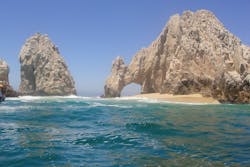Water Supplies in U.S. West & Mexico Projected to Fall
The lakes that store water and supply millions of people in the U.S. West and Mexico are projected to shrink to historic lows in the coming months, according to The U.S. Bureau of Reclamation’s 24-month projections, reported ABC News.
According to the results, there is a very high likelihood of Tier 1 reductions in 2022 and 2023 and an increasing risk of Tier 2 conditions in the near future. This would require Arizona to reduce uses by a total of 512,000 acre-feet. Based on the projections, less Colorado River water will cascade down from the Rocky Mountains through Lake Powell and Lake Mead and into the deserts of the U.S. Southwest and the Gulf of California.
The drop in the water supply levels that could trigger the federal government's first-ever official shortage declaration, which would entail prompt cuts in Arizona and Nevada. The shortage means a reduction in the Colorado River supply available to Arizona. In 2021 the river is currently operating in a “Tier Zero” status, which requires Arizona to contribute 192,000 acre-feet of the state’s 2.8 million acre-foot annual entitlement to Lake Mead, according to The Arizona Department of Water Resources.
According to a joint statement from officials from the Arizona Department of Water Resources and Central Arizona Project, Arizona is prepared for these conditions due to the state’s collaborative efforts that developed innovative conservation and mitigation programs as part of the implementation of the Drought Contingency Plan.
The 24-month study projects the end of water year elevation at Lake Powell to be below 3,575 feet and in accordance with Section 6.B.1 of the Interim Guidelines, Lake Powell will continue to release 8.23 million acre-feet through the remainder of the water year 2021. It is projected that Lake Mead will fall below 1,075 feet (328 meters) for the first time in June 2021.
Seven states rely on Colorado River water, including: Arizona, California, Colorado, Nevada, New Mexico, Utah and Wyoming.
If projections don't improve by August, the Bureau of Reclamation will declare a Level 1 shortage condition and the cuts would be implemented in January, according to the study.
So far, Arizona, Nevada and Mexico have voluntarily given up water under a drought contingency plan for the river signed in 2019, according to ABC News.
In Nevada, the agency that supplies water to most of the state has constructed “straws” to draw water from further down in Lake Mead as water levels fall. A credit system where it can bank recycled water back into the reservoir without having it count toward its allocation has also been created, according to ABC News.
The Bureau of Reclamation projected that Lake Mead will drop to the point that it could threaten electricity generation at Hoover Dam, as the hydropower serves millions of customers in Arizona, California and Nevada.
The study reflects the impacts of the dry and warm conditions across the Colorado River Basin in 2021 as well as the effects of a prolonged drought that has impacted the Colorado River water supply, according to The Arizona DWR.
